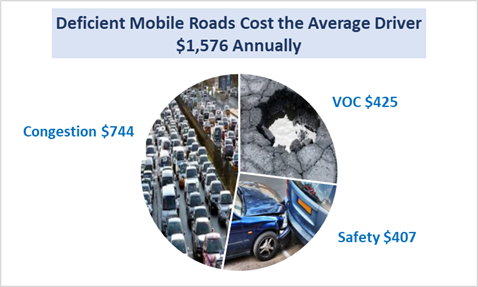FOR IMMEDIATE RELEASE
Tuesday, February 26, 2019
Report available at: tripnet.org
Contact: Rocky Moretti 202.262.0714 (cell)
Carolyn Bonifas Kelly 703.801.9212 (cell)
TRIP office 202.466.6706
MOBILE AREA DRIVERS LOSE NEARLY $1,600 PER YEAR ON ROADS THAT ARE ROUGH, CONGESTED & LACK SOME SAFETY FEATURES – $5.3 BILLION STATEWIDE. LACK OF FUNDING WILL LEAD TO FURTHER ROAD AND BRIDGE DETERIORATION, INCREASED CONGESTION & HIGHER COSTS TO MOTORISTS
Eds.: The statewide report includes regional pavement conditions, bridge conditions, congestion levels, highway safety data, and cost breakdowns for the state’s largest urban areas. TRIP has also prepared customized regional reports for the Anniston-Oxford-Gadsden, Birmingham, Florence, Decatur-Huntsville, Mobile, Montgomery and Tuscaloosa urban areas.
Mobile, Alabama– Roads and bridges that are deteriorated, congested or lack some desirable safety features cost the average Mobile area driver $1,576 per year – a total of $5.3 billion statewide – due to higher vehicle operating costs, traffic crashes and congestion-related delays. Adequate investment in transportation improvements at the local, state and federal levels is needed to relieve traffic congestion, improve road, bridge and transit conditions, boost safety, and support long-term economic growth in Alabama, according to a new report released today by TRIP, a Washington, DC based national nonprofit transportation research organization.
The TRIP report, “Mobile Transportation by the Numbers: Meeting the Region’s Need for Safe, Smooth and Efficient Mobility” finds that in the Mobile area, approximately one third of major locally and state-maintained roads are in poor or mediocre condition and four percent of locally and state-maintained bridges (20 feet or longer) are structurally deficient. The report also finds that the Mobile area’s major urban roads are becoming increasingly congested, causing significant delays and choking commuting and commerce. In addition to the statewide report, TRIP has also prepared regional reports for the Anniston-Oxford-Gadsden, Birmingham, Florence, Decatur-Huntsville, Mobile, Montgomery and Tuscaloosa urban areas.
Driving on deficient Mobile area roads costs the average driver $1,576 annually in extra vehicle operating costs (VOC) as a result of driving on roads in need of repair, lost time and fuel due to congestion-related delays, and the costs of traffic crashes in which roadway features likely were a contributing factor.

The TRIP report finds that 14 percent of major locally and state-maintained roads in the Mobile area are in poor condition and another 18 percent are rated in mediocre condition, costing the average motorist an additional $425 each year in extra vehicle operating costs. These costs include accelerated vehicle depreciation, additional repair costs, and increased fuel consumption and tire wear. Driving on rough roads costs the state’s drivers a total of $2 billion each year.
Traffic congestion in the Mobile area is worsening, causing 32 annual hours of delay for the average motorist and costing the average driver $744 each year in lost time and wasted fuel. Alabama drivers lose a total of $1.5 billion annually in the form of lost time and wasted fuel due to congestion.
“The Mobile Area Chamber of Commerce supports increasing Alabama’s investment in transportation infrastructure to sustain and promote economic growth, job creation, quality of life and public safety. Infrastructure improvements like deepening and widening the Port of Mobile and construction of the new I-10 bridge and bayway expansion are essential,” said Kellie Hope, the Chamber’s vice president of community and governmental affairs.
In the Mobile area, four percent (33 of 941) bridges are rated structurally deficient, with significant deterioration to the bridge deck, supports or other major components. This includes all bridges that are 20 feet or more in length. Nearly half – 49 percent – of Alabama’s bridges are at least 50 years old.
On average, 106 people were killed in traffic crashes in the Mobile area each year from 2015 to 2017. The financial impact of traffic crashes costs each Mobile area driver an average of $407 annually – a total of $1.8 billion statewide. Alabama’s overall traffic fatality rate of 1.34 fatalities per 100 million vehicle miles of travel is higher than the national average of 1.16. The fatality rate on Alabama’s non-interstate rural roads is more than two and a half times higher than on all other roads in the state (2.38 fatalities per 100 million vehicle miles of travel vs. 0.87).
The buying power of the state’s 18 cents-per-gallon fuel tax, last raised in 1992, has been more than cut in half by inflation and increased fuel economy. The vast majority of Alabama’s current transportation budget is devoted to preserving the existing system, leaving only $150 million available annually for new projects.
The efficiency and condition of Alabama’s transportation system, particularly its highways, is critical to the health of the state’s economy. Annually, $432 billion in goods are shipped to and from sites in Alabama, mostly by trucks, relying heavily on the state’s network of roads and bridges. Increasingly, companies are looking at the quality of a region’s transportation system when deciding where to re-locate or expand. Regions with congested or poorly maintained roads may see businesses relocate to areas with a smoother, more efficient and more modern transportation system. More than 940,000 full-time jobs in Alabama in key industries like tourism, retail sales, agriculture and manufacturing are dependent on the state’s transportation network.
“Driving on deficient roads comes with a $1,576 yearly price tag for Mobile motorists – $5.3 billion statewide,” said Will Wilkins, TRIP’s executive director. “Adequate funding for the state’s transportation system would allow for smoother roads, more efficient mobility, enhanced safety, and economic growth opportunities while saving Alabama’s drivers time and money.”